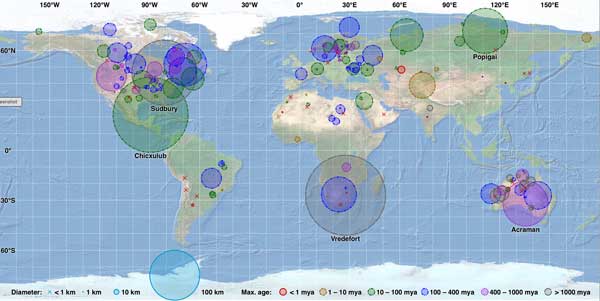 |
The Impact Theory of Volcanism |
Gillian R. Foulger
Department of Earth Sciences, Durham University, Durham, UK; g.r.foulger@durham.ac.uk
See also:
Impact-induced decompression melting: A possible trigger for volcanism and mantle hotspots?
Impact theory suggests that some volcanic areas on Earth resulted from the collisions of extraterrestrial bolides on the surface of Earth. Evidence for impacts includes:
- A recognizable crater, or geological structures consistent with a crater;
- Fragments of the bolide;
- High-density crystalline minerals, produced by the transformation of common minerals to higher-density phases by shock waves, e.g., coesite and stishovite, which are high-pressure “shocked” forms of quartz, and diamonds;
- Shatter cones;
- A lens of brecciated rock, which forms beneath the floor of the crater;
- High-temperature rocks, e.g., laminated, welded blocks of sand, spherulites and tektites, and glassy spatters of melted rock;
- Tektites (small pieces of glass formed from melted rock);
- Pressure-deformed minerals; and
- Geophysical evidence for a buried crater, e.g., from resistivity, gravity gradiometry.
Most impacts raise the temperature of the target rocks sufficiently to melt them. Large impacts may produce voluminous melt. Such impacts may produce so much melt that the usual evidence is obliterated, e.g., the Bushveld Complex (Hamilton, 1970, Rhodes, 1975) and the Deccan Traps (Rampino, 1987; Negi et al., 1993).

Figure 1: Terrestrial impact craters on world map in equi-rectangular projection. Approximately 190 terrestrial impact craters with diameters up to ~ 300 km are known. (from https://en.wikipedia.org/wiki/Impact_crater)
References
-
Hamilton, W.B. (1970) Bushveld complex product of impacts? In J.L. Vissler,
G. Von Gruenewaldt (Eds.), Symposium on the Bushveld
Igneous Complex and Other Layered Intrusions,
Geol. Soc. S. Afr., Spec. Publ. 1, 367-379.
-
Negi, J.G., Agrawal P.K., Pandey O.P, and Singh, A.P. (1993).
A possible K-T boundary bolide impact site offshore
Bombay and triggering of rapid Deccan volcanism, Phys. Earth Planet. Int., 76, 189-197.
-
Rampino, M.R. (1987). Impact cratering and flood-basalt volcanism, Nature, 327 468-468.
-
Rhodes,
1975, New evidence for impact origin of the Bushveld
Complex, South Africa, Geology, 3, 549-554.
last updated 2nd
April, 2020 |
